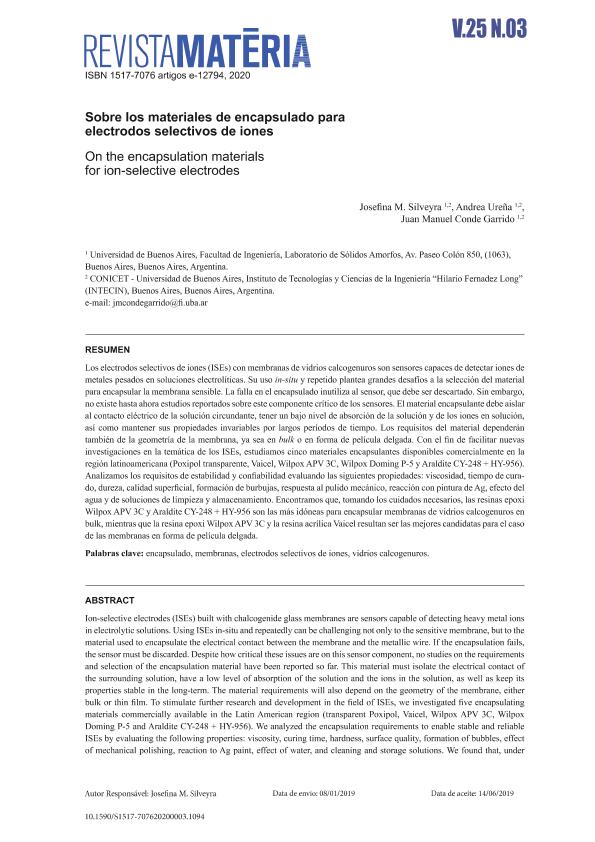Artículo
Los electrodos selectivos de iones (ISEs) con membranas de vidrios calcogenuros son sensores capaces de detectar iones demetales pesados en soluciones electrolíticas. Su uso in-situ y repetido plantea grandes desafíos a la selección del materialpara encapsular la membrana sensible. La falla en el encapsulado inutiliza al sensor, que debe ser descartado. Sin embargo,no existe hasta ahora estudios reportados sobre este componente crítico de los sensores. El material encapsulante debe aislaral contacto eléctrico de la solución circundante, tener un bajo nivel de absorción de la solución y de los iones en solución,así como mantener sus propiedades invariables por largos períodos de tiempo. Los requisitos del material dependerántambién de la geometría de la membrana, ya sea en bulk o en forma de película delgada. Con el fin de facilitar nuevasinvestigaciones en la temática de los ISEs, estudiamos cinco materiales encapsulantes disponibles comercialmente en laregión latinoamericana (Poxipol transparente, Vaicel, Wilpox APV 3C, Wilpox Doming P-5 y Araldite CY-248 + HY-956).Analizamos los requisitos de estabilidad y confiabilidad evaluando las siguientes propiedades: viscosidad, tiempo de curado, dureza, calidad superficial, formación de burbujas, respuesta al pulido mecánico, reacción con pintura de Ag, efecto delagua y de soluciones de limpieza y almacenamiento. Encontramos que, tomando los cuidados necesarios, las resinas epoxiWilpox APV 3C y Araldite CY-248 + HY-956 son las más idóneas para encapsular membranas de vidrios calcogenuros enbulk, mientras que la resina epoxi Wilpox APV 3C y la resina acrílica Vaicel resultan ser las mejores candidatas para el casode las membranas en forma de película delgada Ion-selective electrodes (ISEs) built with chalcogenide glass membranes are sensors capable of detecting heavy metal ions in electrolytic solutions. Using ISEs in-situ and repeatedly can be challenging not only to the sensitive membrane, but to the material used to encapsulate the electrical contact between the membrane and the metallic wire. If the encapsulation fails, the sensor must be discarded. Despite how critical these issues are on this sensor component, no studies on the requirements and selection of the encapsulation material have been reported so far. This material must isolate the electrical contact of the surrounding solution, have a low level of absorption of the solution and the ions in the solution, as well as keep its properties stable in the long-term. The material requirements will also depend on the geometry of the membrane, either bulk or thin film. To stimulate further research and development in the field of ISEs, we investigated five encapsulating materials commercially available in the Latin American region (transparent Poxipol, Vaicel, Wilpox APV 3C, Wilpox Doming P-5 and Araldite CY-248 + HY-956). We analyzed the encapsulation requirements to enable stable and reliable ISEs by evaluating the following properties: viscosity, curing time, hardness, surface quality, formation of bubbles, effect of mechanical polishing, reaction to Ag paint, effect of water, and cleaning and storage solutions. We found that, under the proper conditions, Wilpox APV 3C and Araldite CY-248 + HY-956 epoxy resins are the most suitable materials to encapsulate bulk chalcogenide glass membranes, while Wilpox APV 3C epoxy resin and Vaicel acrylic resin turn out to be the best candidates for thin film membranes.
Sobre los materiales de encapsulado para electrodos selectivos de iones
Título:
On the encapsulation materials for ion-selective electrodes
Fecha de publicación:
09/2020
Editorial:
Universidade Federal do Rio de Janeiro
Revista:
Matéria
ISSN:
1517-7076
Idioma:
Español
Tipo de recurso:
Artículo publicado
Clasificación temática:
Resumen
Palabras clave:
CHALCOGENIDE GLASSES
,
ENCAPSULATION
,
ION-SELECTIVE ELECTRODES
,
MEMBRANES
Archivos asociados
Licencia
Identificadores
Colecciones
Articulos(INTECIN)
Articulos de INST.D/TEC.Y CS.DE LA ING."HILARIO FERNANDEZ LONG"
Articulos de INST.D/TEC.Y CS.DE LA ING."HILARIO FERNANDEZ LONG"
Citación
Silveyra, Josefina María; Ureña, María Andrea; Conde Garrido, Juan Manuel; Sobre los materiales de encapsulado para electrodos selectivos de iones; Universidade Federal do Rio de Janeiro; Matéria; 25; 3; 9-2020; 1-10
Compartir
Altmétricas




